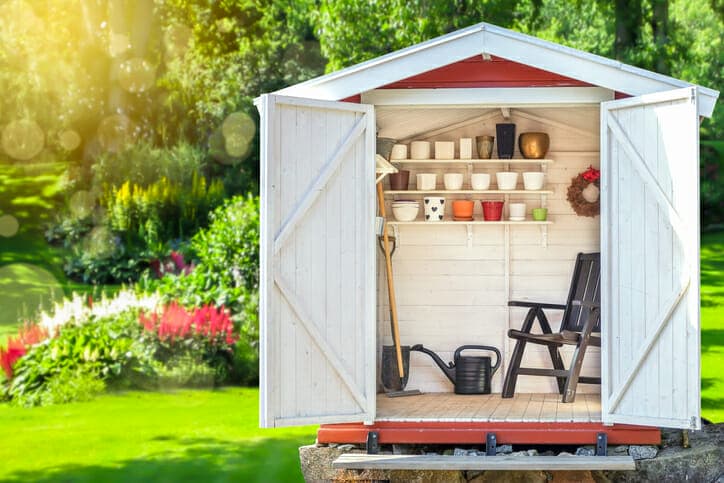
Spring has finally arrived, and we want to spend more of our time outdoors. Having a clean, clutter-free outdoor storage area makes our time outside even more inviting and relaxing.
Many of us have a lot of “stuff” that we store to keep our yards, decks, patios, and any other outdoor areas a place of relaxation. Decluttering our outdoor storage areas makes it easier to maintain our outdoor areas and saves us time so that we can enjoy them.
Outdoor storage areas can get messy and cluttered throughout the year. Because they are not in our main living area it is so easy to just open the door and stick things in. To control the clutter, it helps to divide your storage areas into zones. Each zone has its purpose.
1. Determine the purpose of the outdoor storage area
Possible storage purposes:
- Gardening tools and accessories
- Tools and a workbench area
- Sports and games
- Camping equipment
- Outdoor grilling and cooking
- Extra chairs/tables/coolers for entertaining
- Recycling bins
Once the purposes are determined, it’s time to declutter and organize this outdoor storage space.
Bring everything out of the storage space. If it is a large area or overly cluttered, do it by section.
2. Sort like with like
After grouping your items, put aside any items that are broken or have not been used in the past year. Notice if you have duplicates.
3. Discard what you no longer need
The less you have in your outdoor storage area the easier it will be to declutter and keep organized.
Decide if you want to fix or replace broken items or just trash them. Donate items that are duplicates or that you no longer use. Tool banks can make good use of house and gardening tools in good shape that you are no longer using.
Get rid of expired seeds, old chemicals and paints. Check locally for resources to safely dispose of hazardous waste
4. Containerize what you can
Look for containers to hold your small items. A clear shoe box can hold gardening gloves and small hand tools or packets of seeds. A basket can hold larger tools. A large trash container can hold shovels, rakes, hoes, and other long handled gardening supplies.
Pegboards, hooks, shelves, and cabinets can keep like items together and contained. Maximize your wall space.
5. Clean the area
Knock down cobwebs and sweep the floor of the outdoor storage area while it is empty. This also gives you a good chance to see if there is any structural damage or signs of animals that might have invaded the space.
6. Return items to the outdoor storage area
Decide the logical space for each purpose. Place items that you regularly use near the entrances. Leave walkways between each space. Avoid stacking your containers as you are sure to want something that is in the bottom container. If the containers are not clear, label them.
7. Schedule maintenance
Plan time at each season change to reevaluate what you are storing and where you are storing each item. While lawnmowers may be front and center in the summer, a snow blower may take that place in the winter.
You will be amazed at how much more room you have in your decluttered outdoor storage area once you have discarded the unnecessary and grouped together what you are keeping. You will also find it easier to find the tools you need and to return items to their proper place once you are finished.
If you recognize that you are struggling with an organizing project or want some help or accountability in developing and working any organizational plan join Diane Quintana and me in our Clear Space for You virtual support group.
Jonda S. Beattie, Professional Organizer owner of Time Space Organization, and co-owner of Release, Repurpose, Reorganize. She is based in the Metro-Atlanta area. As presenter, author of four books as well as a retired special education teacher she uses her listening skills, problem solving skills, knowledge of different learning techniques, ADHD specialty, and paper management skills to help clients.
I wish I had a shed like the one in your photo – that’s a thing of beauty!
Cobwebs seem to be my nemesis in outdoor storage areas. They build up, and inevitably leaves become entangled and they don’t easily “blow” out with a leaf blower. So smart to just empty it all and give it a good cleaning, at least once a year.
I think maintenance is the most important step in organizing a shed. It is so easy to throw things in, instead of finding a good way to store them. My snow shoves love falling over in the summer and my rakes love falling over in the winter.
Personally, I don’t have an outdoor storage area, just a from step, but I can see all of these tips being applicable to my clients who have homes and backyards with storage spaces. I love all your tips, and am delighted you mentioned tool banks, an underutilized resource that it good for the users, good for the communities in which they’re located, and good for sustainability!
Great breakdown of how to declutter and maintain. My husband is in charge of our shed/workshop. It’s always cluttered. I wish he would follow your advice.